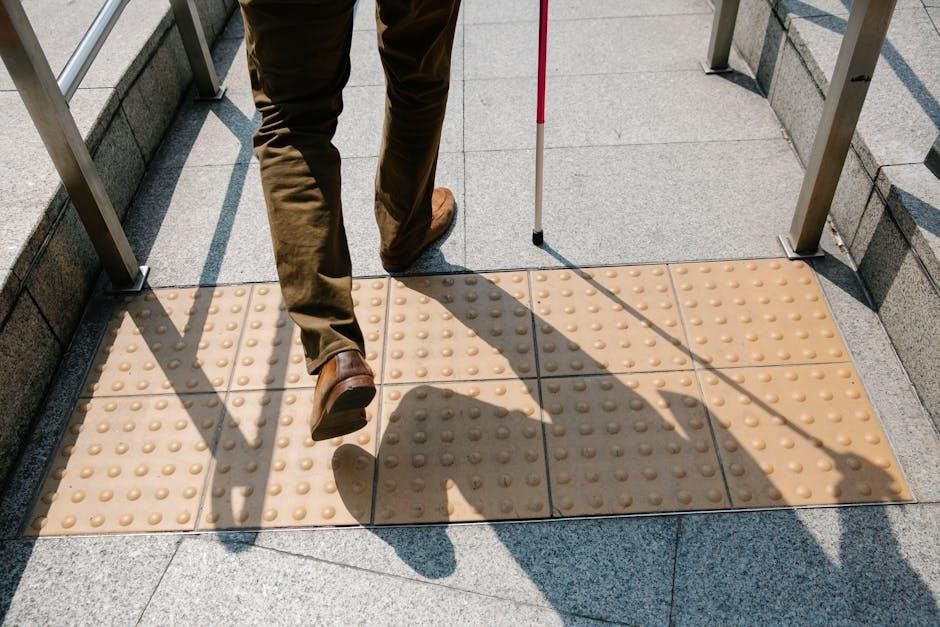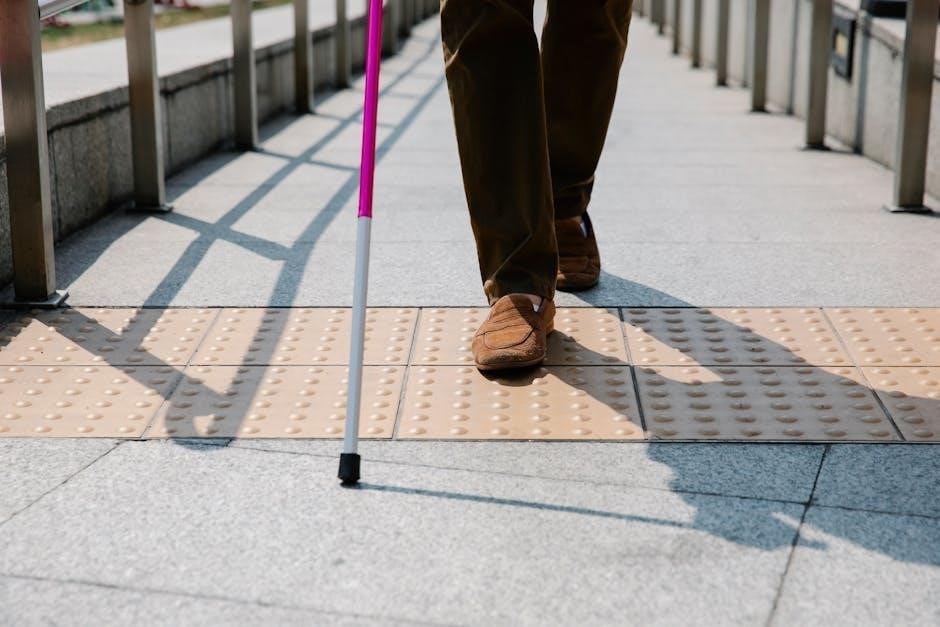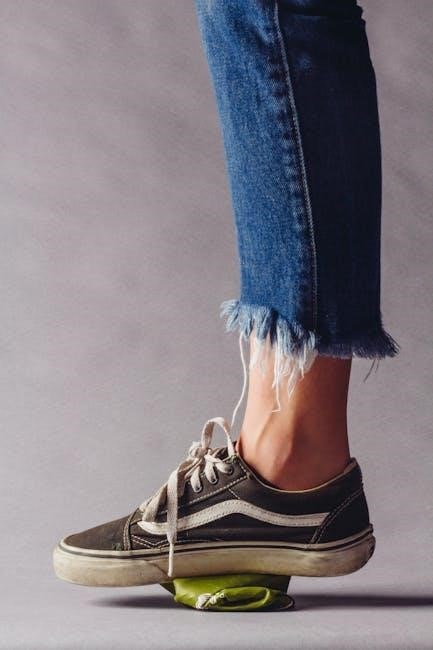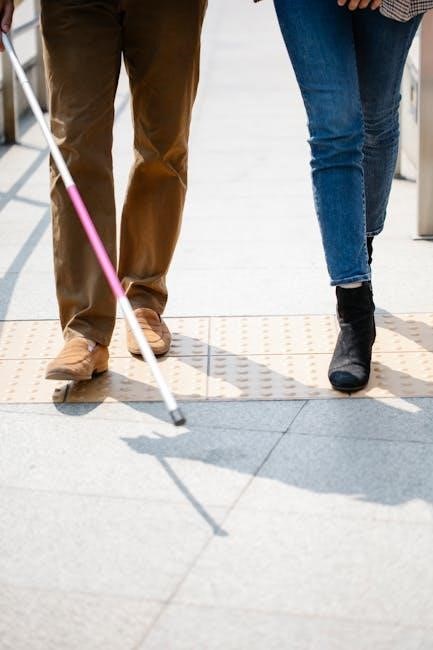Understanding shoe width is crucial for comfort and support. Proper fit prevents discomfort and health issues, while poor fitting shoes can lead to long-term foot problems. This guide helps you navigate the complexities of shoe sizing.
Importance of Proper Shoe Width
Proper shoe width is essential for foot health and comfort. Ill-fitting shoes can cause discomfort, blisters, and even long-term issues like bunions or foot pain. Shoes that are too narrow may restrict toe movement, while overly wide shoes can lack necessary support. Proper fit ensures optimal performance during activities like running or walking. It also prevents foot fatigue and improves overall mobility. Understanding your foot width helps in selecting shoes that align with your foot shape, ensuring better stability and reducing the risk of injuries. Prioritizing proper width is key to maintaining healthy, comfortable feet for everyday activities and sports.
Overview of Shoe Width Sizes
Shoe width sizes vary to accommodate different foot shapes. Common widths include Narrow (N), Medium (M), Wide (W), and Extra Wide (WW). These widths are indicated by letters, with wider options offering more room in the toe box and around the foot. Some brands also use numerical sizing, such as D for standard men’s widths or B for narrow. Proper measurement tools and techniques help determine the best fit. Understanding these sizing options ensures comfortable and supportive footwear. Each width caters to specific foot types, from slim to broader feet, promoting better alignment and reduced discomfort during wear.

Different Shoe Width Sizes
Shoe widths range from Narrow (N) to Extra Wide (WW), ensuring a comfortable fit for various foot shapes. Each size provides specific support and room.
Narrow (N) Width
Narrow (N) width shoes are designed for individuals with slimmer feet, offering a snug fit. This size is ideal for those whose feet are narrower than average, ensuring proper support and preventing excessive movement. Narrow widths are commonly preferred by people with smaller foot dimensions, as they provide a more secure fit during activities like running or walking. However, wearing narrow shoes when feet are wider can lead to discomfort or health issues. It’s important to measure foot width accurately to determine if a narrow size is appropriate. Narrow widths are also popular among athletes who need a tighter fit for better performance and stability.
Medium (M) Width
Medium (M) width is the most common shoe size, catering to the average foot shape. It provides a balanced fit, offering comfort and support for everyday activities. This width is suitable for individuals whose feet are neither too narrow nor too wide. Medium width shoes are versatile, accommodating a wide range of foot types and activities. They are ideal for those who don’t require extra space but still need a comfortable fit. Many brands offer medium width options, making it easier to find a pair that suits various needs. Proper fit ensures optimal performance and prevents discomfort during daily wear or athletic pursuits.
Wide (W) Width
Wide (W) width shoes are designed for individuals with broader feet or those who need extra space for comfort. This size accommodates feet that are wider than average, providing relief from tight fits. Wide width shoes are particularly beneficial for people with conditions like bunions or wide toe boxes. They offer enhanced comfort and support, reducing the risk of foot pain and discomfort. Many brands now offer wide width options, ensuring that everyone can find a shoe that fits well. Proper fit is essential for both daily wear and athletic activities, making wide width shoes a practical choice for those needing more room.
Extra Wide (WW) Width
Extra Wide (WW) width shoes are designed for individuals with very broad feet or specific foot conditions requiring maximum space. This size is ideal for those who find standard wide widths still too restrictive. WW width shoes provide exceptional comfort and support, ensuring no pressure points or discomfort. They are particularly suitable for people with severe bunions, flat feet, or other conditions that demand extra room. While less common than other widths, WW sizes are increasingly available from brands catering to diverse foot shapes. Choosing the right WW width ensures optimal fit, preventing issues like blisters or restricted movement, and enhances overall foot health and mobility.


How to Measure Foot Width
Measuring foot width ensures a perfect fit. Use a ruler or Brannock device to determine width accurately. Proper measurement prevents ill-fitting shoes and foot discomfort, promoting better health. This guide outlines the tools and steps needed for precise measurement, helping you choose the right shoe width for optimal comfort and support. Accurate foot width measurement is essential for selecting shoes that align with your foot shape, ensuring comfort and preventing potential health issues. Follow the step-by-step process to achieve the best results for your foot health and shoe fit. Proper measurement is key to finding the ideal shoe width. Always measure at the widest part of the foot for accuracy. Maintain proper posture and use the right tools for precise results. This ensures comfort and prevents foot problems. Measure both feet, as sizes may differ slightly. Use the larger size for the best fit. Measuring foot width is a simple yet crucial step in selecting the right shoes. It ensures comfort, support, and prevents foot issues. Always measure at the widest point for accuracy. Use a flexible ruler or Brannock device for best results. Proper measurement is vital for optimal shoe fit and foot health. Measure both feet and use the larger size for comfort. This ensures the best fit and prevents discomfort or injury. Measuring foot width is essential for choosing the right shoe size. Use appropriate tools and techniques to ensure accuracy. Proper fit enhances comfort and supports foot health. Measure both feet and consider the widest part for the best results. This guide provides a clear process to measure foot width accurately. Proper measurement is key to finding comfortable and supportive shoes. Use a ruler or Brannock device to ensure accuracy. Measure at the widest point and consider both feet for the best fit. This ensures optimal comfort and prevents foot issues. Measuring foot width is a simple process with the right tools. Use a ruler or Brannock device to determine your size accurately. Proper fit ensures comfort and supports foot health. Always measure at the widest part of the foot for the best results. This guide outlines the tools and steps needed for precise measurement. Accurate foot width measurement is essential for selecting shoes that align with your foot shape, ensuring comfort and preventing potential health issues. Follow the step-by-step process to achieve the best results for your foot health and shoe fit. Proper measurement is key to finding the ideal shoe width. Always measure at the widest part of the foot for accuracy. Maintain proper posture and use the right tools for precise results. This ensures comfort and prevents foot problems. Measure both feet, as sizes may differ slightly. Use the larger size for the best fit. Measuring foot width is a simple yet crucial step in selecting the right shoes. It ensures comfort, support, and prevents foot issues. Always measure at the widest point for accuracy. Use a flexible ruler or Brannock device for best results. Proper measurement is vital for optimal shoe fit and foot health. Measure both feet and use the larger size for comfort. This ensures the best fit and prevents discomfort or injury. Measuring foot width is essential for choosing the right shoe size. Use appropriate tools and techniques to ensure accuracy. Proper fit enhances comfort and supports foot health. Measure both feet and consider the widest part for the best results. This guide provides a clear process to measure foot width accurately. Proper measurement is key to finding comfortable and supportive shoes. Use a ruler or Brannock device to ensure accuracy. Measure at the widest point and consider both feet for the best fit. This ensures optimal comfort and prevents foot issues. Measuring foot width is a simple process with the right tools. Use a ruler or Brannock device to determine your size accurately. Proper fit ensures comfort and supports foot health. Always measure at the widest part of the foot for the best results. This guide outlines the tools and steps needed for precise measurement. Accurate foot width measurement is essential for selecting shoes that align with your foot shape, ensuring comfort and preventing potential health issues. Follow the step-by-step process to achieve the best results for your foot health and shoe fit. Proper measurement is key to finding the ideal shoe width. Always measure at the widest part of the foot for accuracy. Maintain proper posture and use the right tools for precise results. This ensures comfort and prevents foot problems. Measure both feet, as sizes may differ slightly. Use the larger size for the best fit. Measuring foot width is a simple yet crucial step in selecting the right shoes. It ensures comfort, support, and prevents foot issues. Always measure at the widest point for accuracy. Use a flexible ruler or Brannock device for best results. Proper measurement is vital for optimal shoe fit and foot health. Measure both feet and use the larger size for comfort. This ensures the best fit and prevents discomfort or injury. Measuring foot width is essential for choosing the right shoe size. Use appropriate tools and techniques to ensure accuracy. Proper fit enhances comfort and supports foot health. Measure both feet and consider the widest part for the best results. This guide provides a clear process to measure foot width accurately. Proper measurement is key to finding comfortable and supportive shoes. Use a ruler or Brannock device to ensure accuracy. Measure at the widest point and consider both feet for the best fit. This ensures optimal comfort and prevents foot issues. Measuring foot width is a simple process with the right tools. Use a ruler or Brannock device to determine your size accurately. Proper fit ensures comfort and supports foot health. Always measure at the widest part of the foot for the best results. This guide outlines the tools and steps needed for precise measurement. Accurate foot width measurement is essential for selecting shoes that align with your foot shape, ensuring comfort and preventing potential health issues. Follow the step-by-step process to achieve the best results for your foot health and shoe fit. Proper measurement is key to finding the ideal shoe width. Always measure at the widest part of the foot for accuracy; Maintain proper posture and use the right tools for precise results. This ensures comfort and prevents foot problems. Measure both feet, as sizes may differ slightly. Use the larger size for the best fit. Measuring foot width is a simple yet crucial step in selecting the right shoes. It ensures comfort, support, and prevents foot issues. Always measure at the widest point for accuracy. Use a flexible ruler or Brannock device for best results. Proper measurement is vital for optimal shoe fit and foot health. Measure both feet and use the larger size for comfort. This ensures the best fit and prevents discomfort or injury. Measuring foot width is essential for choosing the right shoe size. Use appropriate tools and techniques to ensure accuracy. Proper fit enhances comfort and supports foot health. Measure both feet and consider the widest part for the best results. This guide provides a clear process to measure foot width accurately. Proper measurement is key to finding comfortable and supportive shoes. Use a ruler or Brannock device to ensure accuracy. Measure at the widest point and consider both feet for the best fit. This ensures optimal comfort and prevents foot issues. Measuring foot width is a simple process with the right tools. Use a ruler or Brannock device to determine your size accurately. Proper fit ensures comfort and supports foot health. Always measure at the widest part of the foot for the best results. This guide outlines the tools and steps needed for precise measurement. Accurate foot width measurement is essential for selecting shoes that align with your foot shape, ensuring comfort and preventing potential health issues. Follow the step-by-step process to achieve the best results for your foot health and shoe fit. Proper measurement is key to finding the ideal shoe width. Always measure at the widest part of the foot for accuracy. Maintain proper posture and use the right tools for precise results. This ensures comfort and prevents foot problems. Measure both feet, as sizes may differ slightly. Use the larger size for the best fit. Measuring foot width is a simple yet crucial step in selecting the right shoes. It ensures comfort, support, and prevents foot issues. Always measure at the widest point for accuracy. Use a flexible ruler or Brannock device for best results; Proper measurement is vital for optimal shoe fit and foot health. Measure both feet and use the larger size for comfort. This ensures the best fit and prevents discomfort or injury. Measuring foot width is essential for choosing the right shoe size. Use appropriate tools and techniques to ensure accuracy. Proper fit enhances comfort and supports foot health. Measure both feet and consider the widest part for the best results. This guide provides a clear process to measure foot width accurately. Proper measurement is key to finding comfortable and supportive shoes. Use a ruler or Brannock device to ensure accuracy. Measure at the widest point and consider both feet for the best fit. This ensures optimal comfort and prevents foot issues. Measuring foot width is a simple process with the right tools. Use a ruler or Brannock device to determine your size accurately. Proper fit ensures comfort and supports foot health. Always measure at the widest part of the foot for the best results. This guide outlines the tools and steps needed for precise measurement. Accurate foot width measurement is essential for selecting shoes that align with your foot shape, ensuring comfort and preventing potential health issues. Follow the step-by-step process to achieve the best results for your foot health and shoe fit. Proper measurement is key to finding the ideal shoe width. Always measure at the widest part of the foot for accuracy. Maintain proper posture and use the right tools for precise results. This ensures comfort and prevents foot problems. Measure both feet, as sizes may differ slightly. Use the larger size for the best fit. Measuring foot width is a simple yet crucial step in selecting the right shoes. It ensures comfort, support, and prevents foot issues. Always measure at the widest point for accuracy. Use a flexible ruler or Brannock device for best results. Proper measurement is vital for optimal shoe fit and foot health. Measure both feet and use the larger size for comfort. This ensures the best fit and prevents discomfort or injury. Measuring foot width is essential for choosing the right shoe size. Use appropriate
Tools Needed for Measurement
To accurately measure foot width, you’ll need a few essential tools. A flexible ruler or a Brannock device, commonly found in shoe stores, is ideal for precise measurements. Alternatively, a straightedge or a piece of paper can be used to trace the foot’s outline for later measurement. Ensure the ruler is placed flat against the foot, aligning it with the widest point. Proper tools help achieve accurate results, making it easier to select the right shoe width for comfort and support. Using the correct tools ensures precision and reliability in determining your foot width, which is crucial for finding the perfect shoe fit.
Step-by-Step Measurement Guide
Measuring foot width accurately involves a straightforward process. Start by standing barefoot on a flat surface, ensuring your weight is evenly distributed. Place the flexible ruler or Brannock device across the widest part of the foot, typically just below the toes. Record the measurement in inches or centimeters. For added accuracy, repeat the process on the other foot, as widths may differ slightly. Use the larger measurement to determine your shoe width. Ensure the ruler remains flat and parallel to the floor for precise results. This method provides a reliable foundation for selecting the appropriate shoe width, enhancing comfort and support. Consistency is key to achieving accurate measurements every time.
Best Time to Measure Foot Width
The optimal time to measure foot width is in the evening, as feet tend to swell throughout the day, reaching their maximum size by nightfall. Measuring at this time ensures the most accurate fit, preventing shoes from feeling too tight or restrictive. Avoid measuring in the morning when feet are at their smallest. Consistency in timing helps maintain reliability across measurements. For individuals with fluctuating foot sizes due to medical conditions, consulting a professional for guidance is recommended. Accurate timing is essential to selecting shoes that provide comfort and support throughout the day, reducing the risk of discomfort or foot-related issues. Regular monitoring can also help track changes in foot width over time.

How to Choose the Right Shoe Width
Selecting the right shoe width ensures comfort and prevents foot issues. Consider your foot shape, activity type, and personal comfort preferences when making your choice. Proper fit enhances performance and daily mobility, making it essential to prioritize accurate sizing for optimal support and satisfaction. Always try shoes on and walk around to gauge comfort before purchasing.
Considering Foot Shape and Type
Your foot shape and type play a significant role in determining the ideal shoe width. For instance, people with wider feet or conditions like bunions may require extra-wide shoes to avoid discomfort and pressure. Conversely, those with narrower feet benefit from slimmer designs to prevent excessive movement. Foot types, such as flat feet or high arches, also influence width preferences, as certain shapes provide better support. Assessing your foot’s unique characteristics ensures a more personalized fit, enhancing comfort and reducing the risk of foot-related issues. This step is foundational for selecting the most suitable shoe width for your needs.
Matching Width to Activity Type
Choosing the right shoe width depends on your activity type and lifestyle. For high-impact sports like running, a wider toe box ensures toe movement, reducing blisters and enhancing stability. Hiking boots may require a snugger fit for ankle support, while casual shoes can offer more flexibility. Yoga or studio workouts often benefit from a tighter fit to maintain balance. Consider the demands of your activity—whether it’s running, walking, or athletic training—and select a width that balances support and freedom of movement. Proper alignment of shoe width with activity type ensures optimal performance, comfort, and reduces the risk of injury or discomfort during use.
Trying Shoes On Properly
Trying shoes on properly is essential for ensuring the best fit. Start by wearing the same type of socks you plan to use with the shoes. Stand up to gauge comfort and support. Check if there’s about a half-inch of space between your longest toe and the shoe’s end. The heel should feel snug but not tight, while the width should allow your foot to relax naturally. Avoid shoes that feel too tight or too loose, as both can cause discomfort or blisters over time. If possible, try shoes in the afternoon, as feet tend to swell slightly during the day.

Impact of Shoe Width on Comfort and Performance
Proper shoe width enhances comfort and performance by providing adequate support and preventing foot issues, ensuring optimal fit for various activities and reducing the risk of discomfort or injury.

Effects of Ill-Fitting Shoes on Foot Health
Ill-fitting shoes can cause significant discomfort and long-term foot health issues. Tight or narrow shoes may lead to blisters, calluses, and even conditions like bunions or hammertoes. Conversely, shoes that are too wide can cause instability, affecting balance and posture. Improper fit can also lead to foot fatigue, arch pain, and plantar fasciitis. Over time, these issues can worsen, making daily activities uncomfortable. Proper shoe width is essential to prevent these problems and ensure overall foot well-being. Healthline and other sources emphasize the importance of correct fit to avoid chronic foot health complications.
Enhancing Athletic Performance with Proper Fit
Athletes benefit significantly from properly fitting shoes. A snug yet comfortable width ensures stability, reducing the risk of slippage during sharp movements. This stability enhances control and precision, crucial for sports like basketball or tennis. Proper fit also boosts energy efficiency, as less effort is wasted on adjusting shoes during activity. Additionally, it reduces the likelihood of injuries such as blisters or muscle strains, allowing for better endurance. With optimal shoe width, athletes can maintain peak performance and focus on their game without discomfort. This makes proper fit a key factor in achieving athletic success and overall satisfaction.
Influence on Daily Comfort and Mobility
Proper shoe width significantly impacts daily comfort and mobility. Ill-fitting shoes can cause discomfort, leading to fatigue and difficulty walking. Narrow shoes may compress toes, causing pain and limiting movement. Conversely, overly wide shoes can lack support, leading to instability. Correct width ensures toes have enough space to move naturally, promoting balance and reducing strain on feet and legs. This is especially important for individuals with pre-existing foot conditions. Comfortable footwear enhances overall mobility, allowing individuals to perform daily tasks without hindrance. Thus, selecting the right shoe width is essential for maintaining daily comfort and ensuring optimal mobility throughout the day.

Shoe Width Differences by Brand
Different brands offer varying shoe widths, catering to diverse foot shapes. Some brands specialize in narrow or wide sizes, while others provide a standard range of widths.
Brands Offering Wide Size Options
Several brands are known for their wide and extra-wide shoe options. Hoka One One offers wide sizes, particularly in their running shoes, ensuring comfort for those with broader feet. New Balance is another brand that provides a wide range of widths, catering to different foot shapes. Similarly, brands like Clarks and Ecco offer wide and extra-wide options, focusing on comfort and support. These brands recognize the importance of proper fit and provide various styles to accommodate wider feet, ensuring both comfort and functionality for everyday wear or athletic activities.
Brands Catering to Narrow Feet
Certain brands specialize in offering shoes tailored for individuals with narrower feet. For instance, Hoka One One’s Mach 6 model is known for its tighter fit, making it an excellent choice for those seeking a more snug shoe. Similarly, brands like Nike and Adidas provide narrow width options across various styles, from running shoes to casual wear, ensuring a precise fit. These brands often incorporate sleek designs and advanced materials to accommodate slimmer foot shapes, enhancing both comfort and performance. Additionally, they may offer customizable features to further personalize the fit. By catering to this niche, these brands help individuals with narrower feet find the perfect fit without compromising on style or functionality.
Comparing Width Sizing Across Brands
Shoe width sizing can vary significantly between brands, making it essential to compare measurements rather than relying solely on labels. For example, a “wide” in one brand might feel narrower compared to another. Brands like Hoka and New Balance often offer consistent width options, while others may have more variability. Some brands prioritize performance, offering snugger fits, while others focus on comfort with roomier designs. This inconsistency can make shopping challenging, especially for those with specific width needs. Always check size charts or try shoes on to ensure the best fit, as even the same shoe model can differ across brands.

Shoe Width Guide for Specific Needs
Discover tailored solutions for unique foot needs, such as wide toes, bunions, or flat feet, ensuring optimal comfort and support with specialized shoe widths and features.
Shoes for Bunions or Wide Toes
Shoes designed for bunions or wide toes prioritize comfort and relief. Look for styles with wide toe boxes to accommodate toe spread and reduce pressure; Soft, breathable uppers and cushioned insoles enhance comfort. Some brands offer specific features like stretchable materials or removable insoles for customization. Proper fit is essential to avoid aggravating bunions or wide toes, ensuring a comfortable walking experience. Consider orthotic-friendly options for added support. Brands like Ecco and Clarks often cater to these needs, providing stylish and functional choices. Customizable shoes or those with adjustable straps can also offer a tailored fit for individuals with unique foot shapes.
Shoes for Flat Feet or High Arches
Flat feet and high arches require shoes with specific support features. For flat feet, opt for stability or motion control shoes with firm midsoles and arch support to reduce overpronation. High arches benefit from cushioned shoes with flexible midsoles to absorb shock. Look for brands offering customizable insoles or orthotic-friendly designs. Wide widths accommodate foot spreads, enhancing comfort. Brands like Brooks and ASICS provide excellent options, ensuring proper alignment and reducing strain. Proper fit is crucial to prevent discomfort and long-term foot issues. Consider consulting a podiatrist for personalized recommendations to ensure optimal support and comfort for your specific foot type.
Shoes for Children and Growth Considerations
When selecting shoes for children, consider their rapid growth and developmental needs. Choose styles with adjustable straps or lacing systems to accommodate expanding foot sizes. Opt for shoes with breathable materials and cushioning to support growing bones. Wide widths ensure comfort and prevent tightness, which can hinder proper foot development. Look for brands offering flexible soles to encourage natural movement. Regularly check fit as children’s feet can grow up to two sizes per year. Properly fitting shoes are essential for preventing foot issues and ensuring healthy growth. Prioritize durability to withstand active play while providing the necessary support for developing arches and foot structures.

Future of Shoe Width and Fit Technology
Innovative technologies like customizable shoes and 3D printing are revolutionizing shoe width and fit. These advancements ensure precise measurements and optimal comfort, catering to diverse foot shapes.
Customizable and Adjustable Shoes
Customizable and adjustable shoes are transforming the footwear industry by offering tailored fits. Companies now utilize 3D printing to create shoes that match individual foot shapes precisely; Adjustable features like elastic panels and customizable insoles provide enhanced comfort. These innovations cater to diverse foot types, including wide or narrow feet, ensuring optimal support and reducing discomfort. Brands are also incorporating technology that allows wearers to adjust tightness and width settings for a personalized fit. This trend not only improves comfort but also addresses specific needs, making it easier for individuals to find shoes that align with their unique foot anatomy and preferences.
Role of 3D Printing in Shoe Manufacturing
3D printing is revolutionizing shoe manufacturing by enabling the creation of highly customized and complex shoe structures. This technology allows brands to produce shoes with precise measurements, catering to specific foot shapes and widths. By reducing material waste and speeding up production, 3D printing makes shoe manufacturing more efficient and sustainable. It also opens possibilities for innovative designs, such as lightweight yet durable midsoles and personalized arch support. With 3D printing, brands can offer bespoke solutions, ensuring a perfect fit for individuals with unique foot needs, while maintaining high performance standards and style.